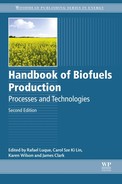10.8. Biogas utilization
Biogas is mainly composed of methane and carbon dioxide, but also contains small amounts of hydrogen sulfide, ammonia, and traces of hydrogen, nitrogen, carbon monoxide, saturated or halogenated carbohydrates, and oxygen. Biogas is usually saturated with water vapor and may also contain particles and siloxanes. The energy content is determined by the methane content (1 kWh per m3 of biogas with 10% of methane).
The biogas can be used in as many applications as the natural gas (heating, combined heat and power systems, fuel cells). There may be different specifications for biogas to be used in different applications, especially when biogas is to be used in stationary appliances or to be fed to a pipeline grid. The biogas needs purification to improve its quality in most cases. Hydrogen sulfide and its oxidation products are the major “contaminants” of the biogas (corrosive) and corrosion starts when the concentration of H2S is above 50 ppm (Gosh, 2007).
Hydrogen sulfide reacts with most metals. Conditions of high pressure and temperature (prevailing during storage or usage of biogas) favor the reactivity of this contaminant. Sulfur dioxide also lowers the dew point of the stack gas. There are biological methods for hydrogen sulfide removal that can be applied in the anaerobic digester as well as other physicochemical methods applicable after biogas has been collected. The biological methods include the supply of a small amount of air to activate the sulfide oxidizing microorganisms (Thiobacillus) grown in a microaerophilic environment on CO2 (autotrophic). The hydrogen sulfide is converted to elemental sulfur but also to sulfate. A combination of biological filter (containing sulfide oxidizing microorganisms) and a water scrubbing step can be used alternatively. Physicochemical methods include the use of iron-containing compounds (iron chloride, iron oxide), activated carbon, water scrubbing, dimethylether of polyethylene glycol (or selexol) scrubbing and NaOH scrubbing. Iron chloride can be supplied into the digester which forms iron sulfide (insoluble) and is applied when hydrogen sulfide is produced at high concentrations.
Table 10.4
Requirements to remove gaseous compounds depends on biogas utilization (Wellinger and Lindberg, 2000)
| Application | H2S | CO2 | H2O |
| Gas heater (boiler) | <1000 ppm | No | No |
| Kitchen stove | Yes | No | No |
| Combined heat and power device | <1000 ppm | No | No |
| Vehicle fuel | Yes | Recommended | Yes |
| Natural gas grid | Yes | Recommended | Yes |

Humidity should also be removed because the presence of water favors the formation of sulfur oxidation products. Water is condensed and frozen under high pressure during biogas storage. Siloxanes can spoil pumps and heat exchangers because they are converted to silicon oxides during the combustion and accumulate on equipment surfaces and reduce heat transfer and equipment lifespan. Adsorption using activated carbon and membrane separation techniques is used to remove siloxanes. Polydimethylsiloxane (PDMS) has been investigated as a membrane material to eliminate siloxanes and other traces of volatile compounds (Ajhar et al., 2012).
Carbon dioxide must also be removed if the biogas has to meet natural gas specifications. Especially if biogas is to be used as a vehicle fuel, its methane content should be enriched until it becomes higher than 90% (Harasimowicz et al., 2007). Suitable methods for carbon dioxide removal include water absorption, polyethylene glycol absorption (the carbon dioxide is better dissolved in selexol), carbon molecular sieves (a series of carbon columns is used to save energy required for pressure application), and membrane separation (with gas phase in both sides of the membrane—high pressure or with a liquid phase in one side for absorption of the carbon dioxide while diffusing through the membrane—low pressure). Halogenated compounds (present in landfill biogas) and oxygen (due to air entrance when landfill biogas is collected) must be removed too. The requirements for removal of these constituents are reported in Table 10.4 depending on the biogas usage.
..................Content has been hidden....................
You can't read the all page of ebook, please click here login for view all page.
